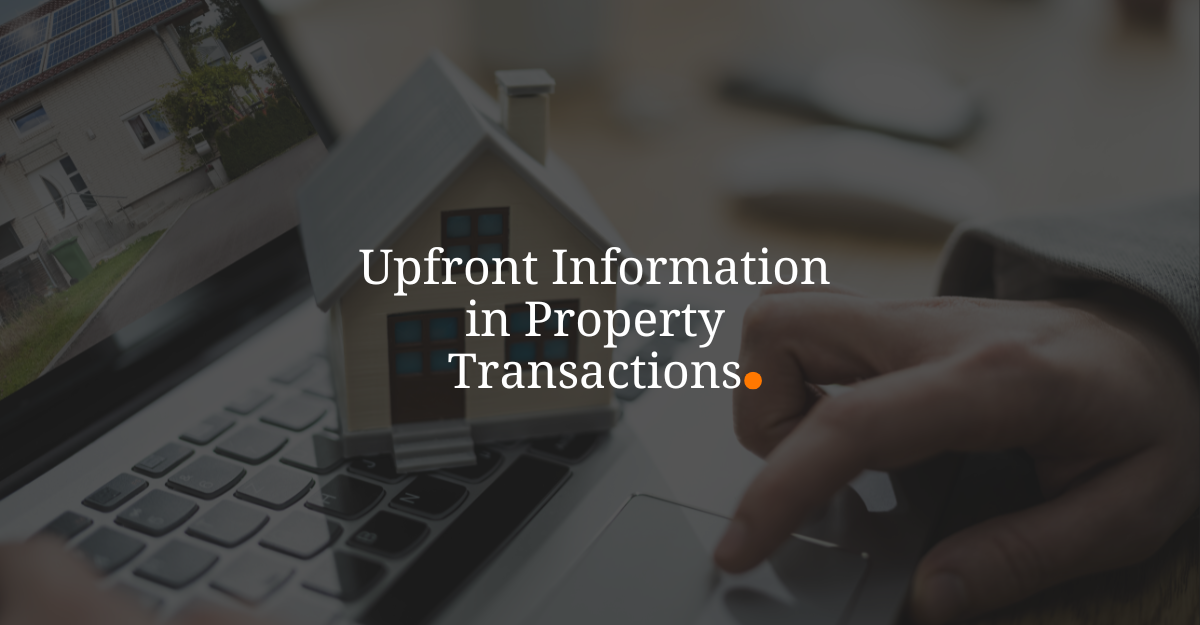Taken from the Mortgage Finance Gazette: https://www.mortgagefinancegazette.com/features/digital-evolution-conveyancing-14-05-2018/
Angela Gordon-Lennox, head of product, environment, legal & mapping at Landmark Information discusses how conveyancing is evolving with the help of digitisation and integration of data.
In a recent Conveyancing Roadshow we conducted with Modern Law, we had the opportunity to directly speak to 60 property lawyers from across the country to understand the current issues, opportunities and trends facing the legal conveyancing sector today.
A theme that was brought up at every session was the changing dynamic of homebuyers: many of the lawyers we spoke to felt that, in today’s digitally-enabled world, consumers have become accustomed to ‘googling’ for information to receive answers ‘on demand’. Plus, with the purchase of goods and services now possible in just one click (and regularly delivered the very next day), there is a growing expectation that this too should be applied to property purchasing.
In the summary of responses to the Government’s review of the home buying and selling process, the whole area of harnessing digital technology is a key topic, with a view to identifying ways of improving the overall speed and transparency, while reducing drop-out rates of the transaction process.
Many solicitors are already adopting new technologies to automate elements of their operations, in a bid to streamline the process and create efficiencies – combined with the added advantage of time and cost savings. By doing so, it frees-up time to handle more complex, individual tasks.
For example, innovations continue with case management tools, automated client update services and intelligent search ordering platforms – all designed to support solicitors conducting their day-to-day conveyancing operations.
When it comes to undertaking property due diligence as part of any transaction, irrespective of whether it’s residential or commercial, it is important to ensure that the right level of analysis is undertaken, without hesitation.
Environmental risks
From a buyers’ perspective, they rely on their lawyer for insight and guidance. A raft of environmental risks have the potential to create expensive problems further down the line – such as ground instability or subsidence, flooding or land contamination, and clients expect their solicitor to be their advisor and alert them to such risks prior to the transaction completing.
If we look at this from a homebuyer’s perspective, we’ve become a nation of online house finders and it’s not until the search is really narrowed down that we venture out to visit prospective properties.
If we then like what we see we go back to our screens and start to find out more information – the power of the internet means we can review neighbourhood information, local schools, house price fluctuations and more before making the decision to go ahead with the purchase. The data is today at our fingertips.
Appointing a conveyancer
It is at this stage that the homebuyer will be looking to employ a conveyancing professional to manage the purchase. A legal services firm can stand out and really meet their needs by delivering access to as much information as possible electronically – not just by emailing rather than printing and posting documents, but through web services that deliver pertinent information even more quickly and easily.
As an example, a key area where such information can be easily digested and understood is the property searches. Here at Landmark, we have been working with legal professionals for over two decades and in this time we have been working hard to understand what improvements can be made to meet consumers’ growing service expectations.
In this time, we’ve seen the cycles of evolution; originally many searches were manual, paper-based reports. Over time this has become more digitised with reports delivered electronically, via PDF, by email. This has evolved to online portals where many legal firms provide clients with a private log-in so they can review all updates and data relating to their case electronically.
In checking any property risks the decision on which standard and non-routine searches to conduct remains up to the conveyancing professional. They will recommend specific environmental reports or similar, agree these with the client and order what is required for review and analysis. We’ve seen that over the years, as digital data has become more readily available, the range of these property reports has expanded. With the increase in volume however, comes the complexity of determining just what is needed for each transaction.
It remains the responsibility of legal professionals to undertake the most appropriate investigations to ensure clients aren’t subject to any loss further down the line and from a general compliance perspective, so it is vital to get this right.
This is achieved by providing clients with all pertinent information on the property, which could have the potential to negatively impact the property. In doing so, this will help avoid any future negligence claim and protect every part of the chain, including lenders
Environmental reports
The good news for conveyancers is that they are not expected to become environmental specialists overnight. A new type of interactive ‘all-in-one’ environmental report is available that presents a number of risks in one single order, saving time and costs from having to access multiple reports.
This report is different from other all-in-one reports on the market as it is consultant-led, meaning that it includes a series of ‘next steps’ directly from a team of qualified environmental specialists. They make it clear what the results mean and offer professional guidance that clients can rely on. Lawyers are not left wondering what to do next.
With additional interactive features these reports present environmental risks in an easy to understand, visual format, making them more consumer-friendly than ever before. Clients can view the risks for themselves in greater detail via web links through to digital maps in order to understand the findings in greater depth.
As such, far more reports will be passed first time round as any ‘at risk’ concerns will be manually assessed by expert consultants at no additional cost. In my view, this not only simplifies the search process but provides real confidence to clients that everything that can be checked, has been checked.
This heightens the chance of progressing a transaction in the most efficient and compliant manner, without delay, which in today’s fast paced world, will tick most boxes on a client’s wish-list.
By accessing as much intelligence on the property as possible and in the format that suits, it delivers complete peace of mind to homebuyers, demonstrates compliance and best practice from the conveyancer’s point of view, and provides extra assurances to lenders.
The digital evolution continues at speed and, as consumer expectation of accessing and using information online become ever more the norm, it’s vital that conveyancers – and every other part of the transaction chain – are able to deliver the next generation client care that homebuyers have come to expect.
Executive summary
- Many solicitors are adopting new technologies to automate elements of their operations but digital technology could be used more in the property buying process. Digitisation can improve the speed and efficiency of home buying, make cost savings, free-up time to handle more complex tasks and reduce transaction drop-out rates.
- Innovations continue to be made with case management tools, automated client update services and intelligent search ordering platforms – all designed to support solicitors conducting everyday conveyancing operations.
- Home buyers increasingly want to receive information, such as property searches, electronically – via emailing and web services. Over time searches have developed from paper-based documents to digitised reports delivered electronically via PDF and email to online portals where clients can review updates and data relating to their case.
- As digital data becomes more readily available, the range of search reports and property risk data has expanded but so has the complexity of determining what is needed for each transaction.
- E-conveyancing aims to create a fully digitised end-to-end process for a property transaction. Conveyancers can interact and share legal paperwork and searches in a digital environment with all parties; manage transfer submissions to Land Registry electronically; and improve identify verification checks.
What about e-conveyancing?
Angela Gordon-Lennox, head of product, environment, legal & mapping at Landmark
Information
The term ‘e-conveyancing’ can often mean different things to different people. Essentially, the overarching aim is to create a fully digitised end-to-end process for a property transaction.
This includes – but is not limited to – enabling property lawyers and conveyancers to interact and share legal paperwork and searches in a digital environment with all parties; create a legal mortgage online and allow the borrower to be able to sign online; manage transfer submissions to Land Registry electronically; as well as improve identify verification checks, and more.
I believe we are now closer than ever before to seeing e-conveyancing take shape. Digital innovations will make the process faster, easier, safer and more cost-effective than ever before.
You’ll be hearing the words ‘integration’ and ‘workflow’ a lot more, as we move ever closer to a seamless digital transaction.
For example, integrating existing working practices such as ordering and assessing property searches into case management workflows will be just one of the steps required to start joining all the dots together.
 There are instances where this has already begun – with legal firms providing the public with the ability to request online quotes online, which are then automatically converted into an active case if given the go ahead to proceed. The appropriate searches are then ordered and delivered directly to the online platform – which both the solicitor and the client can view.
There are instances where this has already begun – with legal firms providing the public with the ability to request online quotes online, which are then automatically converted into an active case if given the go ahead to proceed. The appropriate searches are then ordered and delivered directly to the online platform – which both the solicitor and the client can view.
It’s not until the last two years that we’ve started to see real digital advances appear on the market, some of which may finally present opportunities to change the face of conveyancing as we know it.
From a property search point of view, conveyancers can access products which offer a more intuitive and interactive approach to the due diligence process. Rather than simply read a standard legal PDF report, law firms are able to interact with intelligent maps and datasets that will also appeal to homebuyers. Data from searches can also be supplied in ‘packet’ form, which conveyancers are now integrating.
Smart firms are consuming property and environmental data into their own software and workflows, and so far, I have seen them used to produce content for client care letters, to build risk screening and compliance reports that improve due diligence, through to more creative uses such as responsive, real-time mobiles apps that provide notifications to their home-buying and selling clientele.
For me, it’s about working smarter and closer with every touchpoint of the chain; delivering access to services using digital methods that consumers have become accustomed to.
For now, simply improving communication, providing better access to information and enhancing our workflows remains a priority.
Technology will continue to open up such possibilities, plus with the backing of Government and its pledge to improve the transaction process, we believe 2018 will be the year of evolution for true e-conveyancing to take shape.
Robert Sanderson, Managing Director of Ochresoft:
As a practicing solicitor and also MD of a legal services software business, I have seen many aspects of the property transaction evolve over the last twenty years; digital advances are taking hold and we edge ever closer towards electronic conveyancing.
But what does this mean? Property searches are no longer ordered through the post, but are instead ordered directly or online. Applications to HM Land Registry are now managed through case management systems. Conveyancing correspondence is now managed through email.
A major advancement has been the recent announcement from Government that it has authorised HM Land Registry to use electronic signatures in a number of areas. So, from 6 April 2018, changes to the Land Registration Rules enable digital land registration, including the enablement of electronic signatures relating to HM Land Registry, as well as digital conveyancing documents such as mortgage deeds and property transfers. In fact, Coventry Building Society and Enact Conveyancing completed the very first in April.
The overall aim is to make conveyancing simpler, faster and cheaper, as well as improving security against cyber-attacks or digital fraud.
There is however much work to do. Legal service providers should be using case management with workflows to improve speed and efficiency, however there are many who are yet to use this. Integration isn’t however something that will happen overnight and we await news on the ‘next big thing’ that will take us up another level; however I believe those that are able to make this happen – and fully embrace digital methods of working – are more likely to succeed in today’s marketplace.



